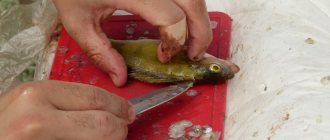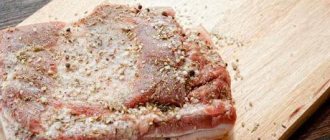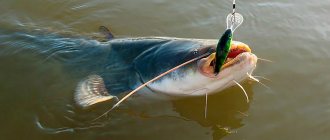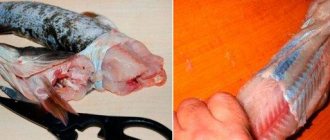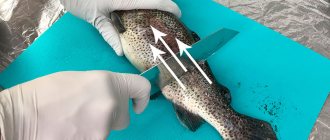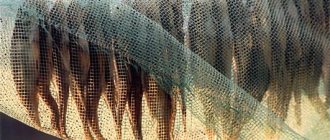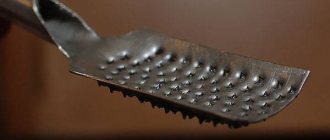How to remove mucus from catfish before cooking?
The convenience of the housewife herself during further processing of the fish and the taste of the finished dish depend on the careful implementation of this procedure. Most often, mucus residues give food its characteristic musty taste and smell. The front fins must be removed before cleaning.
The most common method is cleaning with salt. Rub the carcass generously with coarse table salt and rinse with water. Inspect the fish: most often, after the first wash, a little slippery coating remains on the skin, and large quantities of mucus remain at the base of the fins, near the gill covers and under the head. To completely remove it, you need to carefully wipe all such places with salt powder, rinse again and repeat the procedure again, finally removing the mucous layer from the entire surface.
Cooking in the field (for example, on a picnic or fishing) does not require the presence of large amounts of salt. In this case, the fish is rubbed with fresh ash from the fire. It does not contain such large hard particles as salt crystals, so you need to wash the carcass several times. To better cleanse the mucous membrane, it is convenient to remove the ash layer with the blunt side of a knife, the handle of a spoon, etc.
At home and on the go, you can also use the hot cleaning method. Heat the water (or open the tap) and warm the catfish for 1-2 minutes. The water should not boil; a temperature of +50°C is sufficient. The mucus becomes cloudy, milky, and coagulates, losing its slippery qualities. After scalding, it is easy to clean the catfish: the cloudy film is carefully removed with a blunt, hard object.
You can determine the cleanliness of the skin after removing mucus by running the side of a knife across it bluntly. There should be no residue left on it. Clean catfish skin takes on a lighter shade. Once the mucus has been removed, you can begin to cut up the fish.
Cleaning process before cooking
There are no scales on the body of a representative of this species, but there is mucus with an unpleasant smell of mud. In order not to spoil the dish during the cooking process, you must carefully remove it. Fish can be eaten with the skin if the carcass is properly cleaned and the smell is removed. Beginners who do not know how to clean catfish at home should first familiarize themselves with the sequence of actions:
- The fish is first sprinkled with coarse salt. You can take the carcass and roll it in it.
- Take a cotton napkin and rub it thoroughly over the fish carcass. You can use a glove for convenience.
- Using the blunt side of a knife, remove any remaining salt and mucus from the skin. After this procedure, it should acquire a light shade.
- The carcass is thoroughly washed.
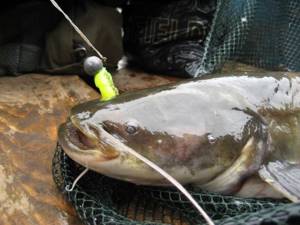
If mucus is not completely discharged, all steps should be repeated until complete cleansing. When cutting up a carcass outdoors, you should use wood ash instead of salt. You can clean the skin without any worries; it is quite durable and rarely damaged.
A step-by-step description allows you to understand how to remove mucus from catfish correctly . When cutting, you need to be careful: the fish has sharp spines on the front fins and you can get hurt by them. To do this, first of all, remove them using food scissors or a knife.
Gutting the carcass
Carefully cut into the skin and muscle layer just under the head of the carcass. Insert the end of the knife into the hole and gradually move it towards the tail, without plunging into the depths of the abdomen. Having cut to the end of the abdominal cavity, all the offal and intestines are taken out, trying not to damage the gallbladder: it is located closer to the head, in the liver mass.
A thick film will remain in the abdominal cavity, which needs to be picked up at the ridge and removed. If it breaks, scrape it off with a knife, eliminating it as much as possible. Remove the gills from the head. After removing the entrails, rinse the carcass inside and out. Leave for a short time to allow the water to drain, or blot with a napkin.
Cleaned catfish is ready for further filleting or portioning, depending on the chosen cooking recipe.

Filleting
They begin filleting the catfish carcass only after complete cleaning. Most often, the skin is also removed before cutting. The prepared fish is placed on its side to remove the head. Then a transverse incision is made at the base of the caudal fin. You need to cut through all the muscles on 1 side up to the spinal bone, but do not cut it.
Then they begin to trim the meat, holding the knife parallel to the table. For large fish, this is done in stages, gradually deepening the cut and carefully removing the layer from the spine and bones from the upper and lower sides. Having reached the beginning of the rib part, they continue to trim the meat only on the back, leaving the ribs intact. When the cut reaches the end, the knife is turned parallel to the ridge and the fillet is cut from the rib part, moving the blade from the spine to the edges of the cut on the belly.
The cut fillet does not contain small bones. If the meat was removed from the ribs carelessly, several bones will remain on the surface of the abdominal wall on the inside. They must be removed individually.
The half with the vertebral bone is turned over with the flesh facing up, the meat is cut to the spine and the procedure is repeated.
The severed head, ridge with caudal fin and skin do not need to be thrown away. They are used to prepare a delicious broth for fish soup or aspic, and the skin is now considered a fashionable decoration and flavoring addition to fish dishes. It is cut into thin “noodles” and fried in oil.
Characteristics of fish
You can meet catfish in almost every major river in Russia. To catch it, you should go night fishing. During the day, representatives of this species burrow deep into the mud and lie on the muddy bottom. Some adult individuals can gain weight up to three centners and have a length of about five meters.
Such specimens are found infrequently, and it is not always possible to get them out of the water. Individuals weighing up to 20 kg are used to prepare various fish dishes. When cooked correctly, the meat of young fish has an amazing taste.
It should be noted that representatives of this species do not have scales, unlike other fish. This fact greatly facilitates cleaning. The process of cutting catfish is also not particularly difficult due to the absence of small bones in the muscles and tail. Its structure assumes only the presence of a ridge and ribs.
Skinning catfish
To properly skin a catfish before filleting, you need to prepare pliers or reliable tweezers. The tool is useful for picking up the edge of the skin when starting to clean. When a large flap is removed, it will be convenient to hold it with your fingers.
Most often, the skin is removed from a whole, not yet gutted catfish carcass. If it is possible to hang the fish by the gills, it is better to do this for a more convenient procedure. Then the skin can be removed with a stocking, but with special effort.
In a suspended catfish, the skin around the head is cut and the muscle layers are slightly trimmed to grasp the edge. Sipping the elastic, durable skin, gradually separate it from the meat. Gradually it begins to turn inside out and it becomes easier to remove. Continuing to pull and separate the skin from head to tail, remove it completely, and again cut in a circle near the tail. They pull it off the fin and set it aside. The catfish is then gutted and cut up using traditional methods.
You can make the procedure easier by pre-smoking. This method helps to completely kill the unpleasant odor. But this method has a drawback: smoking must be done carefully so as not to overheat the skin. If it loses elasticity, it will tear, and it will not be possible to tear it off with a stocking.
If the catfish is large and there is nowhere to hang it, proceed differently:
- make a circular incision at the head;
- run the knife along the back, but do not cut the muscles too deeply;
- a corner of the skin is separated near the head at the intersection of 2 incisions;
- pull up and back, cutting the subcutaneous layer of the film.
Gradually moving from head to tail, remove the skin from the catfish. After removing the skin on one side, turn the carcass over and clean the other half. This method can be used to process both whole and already gutted fish.
The skin from a large fish is often cut off after cutting into portions. The filleted meat is cut into slices and each one is placed skin side down. Using a sharp knife, cut along the junction of the skin and muscles on the dorsal side, holding the piece with your hand. Then the meat is lifted, and the knife continues to separate the skin until the end. The disadvantage of this method is that meat cuts remain on the skin, i.e. it is not very economical.
Cleaning the skin from catfish helps remove the unpleasant odor almost completely. Its main part is contained in the skin and mucus, and the meat itself can smell only in large fish.

Elimination of specific odor
Even with proper cleaning and complete removal of the skin, catfish meat still has a faint muddy aroma. You can completely get rid of the smell of mud by marinating the fish before preparing dishes from it. For pickling, use lemon juice or dry white wine.
The carcass, cut into pieces, is placed in a suitable container, and the juice from the cut lemon is squeezed onto the meat. You can use orange or lime. If wine is used to prepare the marinade, the pieces are moistened with alcohol. There is no need to pour too much liquid, just drizzle the fillet well. After moistening with marinades, leave the meat for 20-25 minutes. You can rinse it with water before cooking.
To eliminate the muddy taste, fresh milk is also used. It will take a long time to soak the pieces of somyat in it. The process takes at least 3 hours, but after this treatment the meat becomes tender and has a special taste.
To remove the smell of mud, spices are traditionally added when preparing catfish dishes. Black pepper goes best with fish. It is used in ground or whole form. Allspice (Jamaican) pepper, nutmeg, and fenugreek go well with catfish. You can put fresh dill and parsley, bay leaf and onion in your ear.
Bake in the oven
Components:
- catfish (loin) – 0.7 kg;
- egg – 1 pc.;
- white bread – 2 pieces;
- mushrooms – 0.6 kg;
- onions – 4 pcs.;
- spices “For fish”;
- sour cream 20% - 2 tbsp;
- flour – 1 tbsp;
- filtered water – 200 ml.
Cooking time: 50 min.
Amount of kcal per 100 g: 173.

How to cook catfish cutlets in the oven:
- Prepare minced meat from the fish fillet;
- Finely chop the mushrooms and fry them together with chopped onions;
- Combine the fried mushrooms with minced fish, and then season everything with a mixture of spices and mix thoroughly;
- Form round cutlets and quickly fry them until golden brown in hot vegetable oil;
- Place the fried cutlets in a heat-resistant dish with high sides and pour in sour cream sauce (combine sour cream, flour and filtered water). Place the form with cutlets in an oven preheated to 190 degrees for 15 minutes.
Safety precautions when cutting
The common catfish, which is caught in all regions of Russia, has no spines on its body, no sharp plaques or scutes. The main danger is represented by 2 spikes on the front fins (near the head). They need to be cut off immediately, otherwise you can get seriously injured when cleaning the mucus. The rest of the feathers do not have spines.
Filling or skinning is done by holding the knife with the blade away from you and moving it in the same direction. This will avoid accidental injury.
Southeast Asia is rich in different species of catfish (for example, pangasius or channel catfish), which are also sold in Russia. When purchasing such fish uncut or catching it yourself, it is not recommended to use its spine and head for fish soup: the bones of a number of varieties may contain toxic substances.
